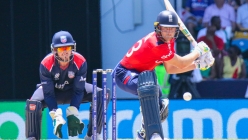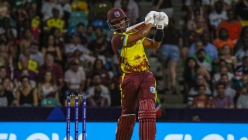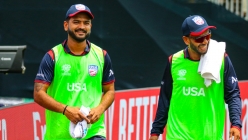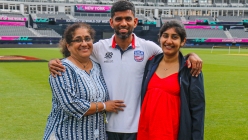Views
USA Cricket: 2023 World Cup Qualifier Tour Report Card Part Three – Outlook for 2024-2027 CWC League 2
2023 Aug 10 by DreamCricket USA
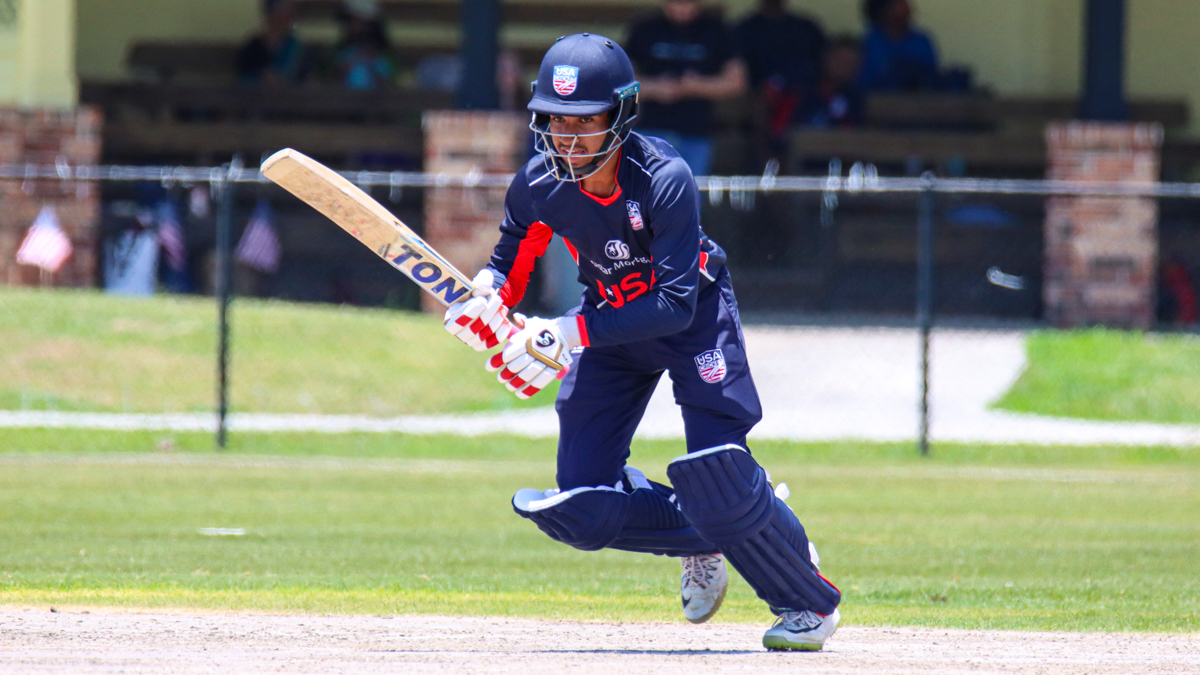
By Peter Della Penna (Twitter @PeterDellaPenna)The time to plan for the 2027 World Cup begins now. Here's a roadmap for USA over the next four years to get to that destination, including building around a cornerstone player like Sai Mukkamalla.
Photo credit: Peter Della Penna
1 – Play for Now or Play for 2027
In the post-tournament review after USA first gained ODI status in April 2019, the same topic was raised with one specific focal point: do you keep picking players now if they are realistically not going to be in the team by the time the World Cup Qualifier and/or World Cup rolls around four years from now? This author’s philosophy is to say no, those players should not continue being selected.
At the time, the specific dilemma related to the likes of players such as Timil Patel and Elmore Hutchinson and the case was made that neither should continue to be picked for ODIs for USA if they were not going to be in the team by the time the 2023 World Cup Qualifier rolled around and instead, those slots should be used to develop newer players and identify roles for the 2023 World Cup qualification cycle.
Both Hutchinson and Timil were give 10 and six matches respectively, while both were also taken on numerous tours where they rode the bench before they were eventually cut loose. Those tour and match selections amounted to wasted opportunities for USA to find and develop players for those roles earlier. USA’s lack of direction and understanding of roles was still apparent by the time they got to Zimbabwe for the Qualifier whereas most other teams had clear understanding of roles and duties performed over the course of the previous three years.
USA wound up using 27 players over the course of CWC League Two, second most only to Nepal, once again highlighting USA’s instability and lack of vision from the start of the cycle. Nepal chopped and changed regularly over the first two years, which contributed to their run of inconsistent to poor results. However, it is no surprise that Nepal’s extraordinary winning streak over the final three tri-series in the cycle – they won 11 of their final 12 matches – was a consequence of finally arriving at a settled formula for the starting XI and keeping faith with those players. It allowed them to leapfrog USA into the top three of the table to guarantee an automatic berth at the World Cup Qualifier in Zimbabwe.
Keeping all of these things in mind, there are a number of players who may be on the chopping block. First and foremost is Nisarg Patel. He will be 39 by the time the 2027 World Cup arrives. His overall ODI stats don’t look too bad: 42 wickets at an average of 30.50 and a 4.75 economy rate. Scratch beneath the surface and it tells a different story. Against teams who like USA fell back to the CWC Qualifier Playoff (Namibia, Papua New Guinea, United Arab Emirates, Jersey, Canada), Nisarg is USA’s leading wicket-taker in ODIs with 30 at an average of 21.30 and a 4.53 economy. Compare that to his record against teams with records above USA (Oman, Scotland, Nepal, Netherlands, Zimbabwe, West Indies) and Nisarg’s record is grim: 12 wickets in 18 matches at an average of 53.50 and a 5.00 economy. Most recently, Nisarg rode the bench for the entirety of the 2023 MLC tournament as he watched Harmeet Singh thrive on the field.
To highlight the disparity in quality of performances by USA’s best players against top-class teams, Saurabh Netravalkar is USA’s best bowler overall against the top-class teams in ODIs for USA (Oman, Scotland, Nepal, Netherlands, Zimbabwe, West Indies) with 30 wickets in 17 matches at an average of 22.86 and a 4.55 economy. In terms of spinners, Nosthush Kenjige was USA’s best against the same opponents with 19 wickets in 16 matches at an average of 30.26 and an economy of 4.44. Pair this with the fact that Nisarg often occupied the pivotal No. 7 batting spot for USA in which he made a negligible impact (one half-century in his ODI career in a loss to Oman, average of 17.71 with a strike rate of 68.13) and the fact that Nisarg is an average fielder means it is time to move on, especially when there are no shortage of other left-arm spin options around the USA who are not only better spinners, but also ones who contribute way more at bat and in the field (Karima Gore, Vatsal Vaghela, Harmeet Singh, Ali Sheikh).
For those who have forgotten, the 2027 World Cup expands again to 14 teams. In spite of USA’s woeful performance at this year’s Qualifier in Zimbabwe where they were trying to force their way into a 10-team World Cup, USA has a realistic shot of being one of at least two Associate teams in the 2027 World Cup event. Doing so would be historic, the first time USA makes the 50-over Men’s World Cup. But they can only achieve that if they begin planning that squad now instead of in October 2027.
2 – USA needs match-winners
But Nisarg is not the only player who needs to be left out of USA's plans for the next four-year cycle. Sushant Modani will be 38 by the time the 2027 World Cup arrives. An average of 26.80 in 31 ODIs as an opener with one century and six half-centuries is not good enough, especially for someone who adds little value in the field. There may be question marks around Gajanand Singh's age (he will be 40 by the time the 2027 World Cup starts) and fitness, but the reality is that he is in outstanding form for USA with the bat and has been a consistent match-winner for them over the last 18 months, far more so than Modani. Fitness permitting, Gajanand remains firmly in USA's planning for the next four years.
In USA’s entire run in Cricket World Cup League Two, they had a total of seven Player of the Match winners. Five of them won the award multiple times. Aaron Jones (twice), Steven Taylor (five times), Monank Patel (four times), Saurabh Netravalkar (twice), Gajanand Singh (three times). Across the entirety of League Two, USA had a total of five centuries scored. They also got another century from Sai Mukkamalla at the CWC Qualifier Playoff in a record-setting chase against the UAE. Compare this to the Player of the Match performances by USA’s opponents in wins over USA:
JP Kotze (Namibia) – 136 off 109 balls; in the same match, Zhivago Groenewald took 5 for 20
Josh Davey (Scotland) – 26* off 25; 2 for 46
Mohammad Nadeem (Oman) – 55* off 85; 3 for 43
Karan KC (Nepal) – 12 off 21 balls; 4 for 15
Aqib Ilyas (Nepal) – 105 off 123 balls; 3 for 14
Sandeep Lamichhane (Nepal) – 6 for 16
Kushal Bhurtel (Nepal) – 84 off 93
Mohammad Nadeem (Oman) – 32 off 66; 2 for 34
Ayaan Khan (Oman) – 41 off 82; 4 for 36
Richie Berrington (Scotland) – 107* off 90
Vriitya Aravind (UAE) – 102* off 108
Kashyap Prajapati (Oman) – 103 off 115
Calum MacLeod (Scotland) – 117 off 91
Calum MacLeod (Scotland) – 133* off 144
Sese Bau (PNG) – 70 off 96; 1 for 25
Assad Vala (PNG) – 64 off 89; 3 for 17
Bernard Scholtz (Namibia) – 17* off 34; 3 for 5
Gerhard Erasmus (Namibia) – 87* off 72; 1 for 38
Jan-Nicol Loftie-Eaton (Namibia) – 43* off 55
Harsh Thaker (Canada) – 43 off 73; 2 for 30
Jason Holder (West Indies) – 56 off 40; 1 for 36
Karan KC (Nepal) – 4 for 33
Scott Edwards (Netherlands) – 67* off 60
Sean Williams (Zimbabwe) – 174 off 101
Craig Young (Ireland) – 3 for 35
Asif Khan (UAE) – 151* off 145
There were nine centuries scored in Player of the Match performances against USA, not to mention seven half-centuries. Whereas USA could only manage five centuries across all of their matches in League Two. Very rarely was there a type of middling, bits and pieces performance by an opposing player that was deemed match-winning. But those are the types of performances that USA players seem to specialize in. Add in the fact that USA’s players in Zimbabwe by and large looked old and slow in the field and it underscores the need for a revamp to cut loose some of the older players like Nisarg, Modani, and Usman Rafiq – who will be 39 by the 2027 World Cup – and move forward. In their place, an emphasis needs to be put on finding match-winners and sticking with them.
Shayan Jahangir showed great promise in Zimbabwe with his century against Nepal in addition to his consistent batting displays elsewhere, including most recently with MI New York in year one of Major League Cricket. Sai Mukkamalla showed both with his century against the UAE in April at the CWC Qualifier playoff and his half-century against Ireland in Zimbabwe that he merits a long-run in the side and should be a central figure in USA’s plans for 2024-2027.
But where else does the search for match-winners to bring into the USA squad come from?
3 – The MLC/ACE new wave conundrum
There has been much conjecture on social media regarding USA’s squad composition for Zimbabwe, specifically why the likes of Corey Anderson, Shadley van Schalkwyk and Smit Patel were not chosen. According to MLC/ACE sources, all three were eligible. According to a USA Cricket official, only Smit Patel was eligible, having recently become a US citizen, while the same official says that Anderson and van Schalkwyk were not technically eligible.
According to a USA Cricket official, the information they received was that both players were short of completing their three-year ICC residency qualification and that a special exceptional circumstances application needed to be filed with the ICC to get them to play in Zimbabwe, and that the ICC typically only approves one such application within a set time period per country/squad. USA Cricket chose not to file such an application for Anderson nor van Schalkwyk because according to the official, neither player made USA Cricket aware of their interest in representing USA.
Multiple USA Cricket officials also claim that they have made repeated requests to ACE/MLC for information regarding arrival dates into the USA for numerous players who have allegedly been signed to ACE/MLC contracts – requests made to ascertain who may be eligible and when to play for USA – but that ACE/MLC has not complied with such requests. This author has separately made similar requests for arrival date/residency qualification timeline information from ACE/MLC officials with similar results in terms of no information being supplied.
Regardless of which side you choose to believe in this saga (one, both, neither), it meant that USA did not pick anywhere close to their best available squad for Zimbabwe. USA’s failure to groom a legspinner to replace Timil Patel (Yasir Mohammad was tried for three matches in the summer of 2022 and then discarded) came back to bite them. Ian Holland, who was so crucial in numerous matches for USA, was not available for the same County Cricket commitments that depleted the Netherlands in Zimbabwe. Cameron Stevenson was left out for reasons unknown despite an excellent record (only Ali Khan had a better strike rate than Stevenson for USA in League Two).
There are a number of spots up for grabs. But who should be filling them? On paper, the 32-year-old Anderson’s historic record for New Zealand as well as his recent batting performances for San Francisco Unicorns in MLC mean he should walk into USA’s middle-order and would be a core player through the 2027 World Cup when he would be 36. But, does he actually want to play for USA?
Harmeet Singh is another who has been frequently discussed as a potential option for USA. He had a good MLC and has been a standout player in Minor League Cricket as well. He would be 34 by the time the next World Cup rolls around. A: Does he want to play for USA? B: Would it make more sense to use a spot vacated by Nisarg to go to a player like 20-year-old Ali Sheikh, who has come up through the USA U19 system, has bundles of talent with the ball, bat and in the field, but also underscores the historic development issue of American cricket where nobody knows how homegrown players will fare compared to an ex-first-class overseas pro because the homegrown player is never given a chance and 99 times out of 100 loses out in a head-to-head selection discussion against an ex-overseas pro?
Other names have been discussed in recent times as well. In addition to Anderson, van Schalkwyk, Harmeet and Smit Patel, there are the likes of Andries Gous, Unmukt Chand and Sami Aslam. Similar questions arise. A: Are they interested in even playing for USA? But another much more pertinent one is B: Do any of these players represent a vastly significant upgrade over the homegrown organically developed domestic talent to merit selection? Chand has been a solid scorer in Minor League Cricket, but his performances in MLC have once again highlighted a historic issue in his career in that he has never been able to bridge the gap against elite talent. Sami Aslam never even took the field for Texas Super Kings, which raises a red flag. Gous has had a far more productive and consistent record both in Minor League and also showed flashes of what he is capable of against top-class bowling in MLC with Washington Freedom.
Realistically, the only newly or soon to be eligible players who have made a solid case for inclusion in a USA lineup are Anderson, Gous and Harmeet. Others like van Schalkwyk and Smit Patel present interesting discussions about how much value they would offer over incumbents, not to mention the merits of picking them over the likes of homegrown players like Ali Sheikh, Jessy Singh or even Abhishek Paradkar – who is just 22 years old but showed clear promise in Zimbabwe as a left-arm pace bowler – and what kind of message that sends to other homegrown players in the pipeline. There are no easy decisions in this scenario. But standing pat with the status quo is also not a viable option for future success either.
4 – The Aaron Jones conundrum
When Jones made his debut for USA, he was an indispensable part of the lineup and saved USA’s bacon too many times to count both at WCL Division Three in Oman and again at Division Two in Namibia to help USA secure ODI status. He continued that good form for the first several tri-series of League Two in 2019, including arguably one of his best knocks against UAE at Sharjah when he was caught on the boundary for 95 trying to bring up a century with a six, as well as a pivotal 74 against Scotland in Sharjah during a famous win by 35 runs.
But in the three years since, Jones has not just stagnated but arguably gone backwards. From his position at No. 4, he has gone from being a match-winner to a match-stretcher. He soaks up deliveries to make the game go long and deep, attempting to set it up for Gajanand Singh or someone else to fly in and save the day during the final 10 overs (like Jaskaran Malhotra did in Aberdeen in August 2022). Sometimes it works. The majority of the time it holds USA back and costs them dearly because quite often Jones’ approach serves only to put pressure on every other player in the lineup.
In particular, Jones is a habitually slow starter. Rahul Jariwala was made the scapegoat for USA’s tie that felt like a loss against Nepal at Pearland, Texas in the summer of 2022 when he was runout off the final ball. What most people overlooked in that match was Jones, who entered in the 42nd over on the flattest wicket any USA player will play on in their entire careers – after all, he arrived following a 200-run partnership between Steven Taylor and Monank Patel – and proceeded to block his first five deliveries against spin bowling. Jones also regularly jogged singles rather than push for twos and it was he who got out to a full toss on the penultimate delivery, picking out the only boundary rider when Nepal had packed the ring to deny the winning run.
Despite being USA’s fastest runner, he is hands down USA’s worst runner between the wickets. That much was on display in Zimbabwe for his role in multiple runouts, including the Gajanand Singh tag-team debacle against Zimbabwe.
In spite of all of this, Jones finished second in runs for USA in League Two with 1184 runs, only 35 behind Monank Patel. Jones’ average of 42.28 is far superior to Monank’s and most likely he would have finished with more runs overall than Monank had he not missed four matches due to a hand injury.
Still, the reality is that there is a two-fold problem with Jones. First, his one-gear approach was perfectly suited to playing 200-240 totals against the likes of Denmark, Kenya, Singapore and Papua New Guinea at Division Three/Challenge League level. But with a handful of exceptions, that one-gear approach is not a recipe for team success (though the stats will show he continues to grind out runs, albeit with slow strike rate half-centuries) against the likes of Scotland, Oman and Nepal, let alone higher echelon teams at the Qualifier like Netherlands, Zimbabwe and West Indies. As a byproduct of that, part two is that his slow starts put way too much pressure on the rest of the middle and lower order to compensate for his go-slow approach.
A deeper look at Jones shows that not only is he a notoriously slow-starter, but he is a slow batter against spin. However, the rare times he has entered very quickly after the fall of two wickets in the Powerplay, or the rarer times he is able to bat through to the 50th over, he can be a devastatingly quick scorer both in the Powerplay and at the death against pace bowling. His career-best 123 not out off 87 balls against Scotland in Aberdeen showed as much, an innings on an exceptionally flat wicket where he moved along at his typical 70 strike rate against spin bowling but exploded for 48 runs off 12 balls in the final three overs against Safyaan Sharif, Gavin Main and Adrian Neill.
USA previously tried Jones very briefly as an opener in the doomed February 2020 tour of Nepal. He made 5 off 9 against Nepal and 12 off 29 against Oman in the two opportunities he had. However, it may have simply been a case of the right idea at the wrong time. The emergence of Shayan Jahangir has given USA an immensely valuable middle-order finishing option. Though he has mostly been an opener in his development, Sai Mukkamalla has also shown great promise in the middle order for USA with his two highest scores coming at No. 3 (120 not out off 114 balls v UAE) and No. 4 (55 off 46 balls v Ireland).
For starters, Jones cannot be in any USA T20 squad plans for the 2024 T20 World Cup. He showed how much he weighed down the T20 lineup at last year’s T20 World Cup Qualifier in Zimbabwe. His bowling was catastrophic in the match against Zimbabwe at the T20 Qualifier when Sikandar Raza tore him apart, and he failed spectacularly against Netherlands in the knockout match with a spot in the World Cup on the line, wasting the great start provided by Steven Taylor and Monank Patel to scratch his way to 15 off 19 balls at No. 3 before he was runout. Aside from that, he is an anonymous fielder. Seeing the depth of batting options USA has at their disposal in T20 cricket, it would be ludicrous to keep him in their T20 World Cup plans.
But as for the ODI side, Jones is still a crucial part of USA’s setup. Knowing that Jones likes pace on the ball and his frequent slow-scoring starts when entering against spin bowling in the middle overs, USA may be best served sending Jones to open the batting in ODIs going forward. He is someone who frequently opened in his junior career in Barbados, and did so with tremendous success, so he would not be unaccustomed to the role. If Jones has a slow start as an opener, it is far easier for USA to compensate in that position than it is when he makes a slow start after entering in the middle order in the 20th or 30th over.
Separately, Jones would provide a solid foil to Taylor’s explosive six-hitting in the Powerplay. A USA lineup of Jones and Taylor opening, followed by Monank Patel at No. 3, then a middle order of Mukkamalla, Gajanand and Jahangir (and perhaps Corey Anderson slotted in at 5, if he wants to play for USA, leaving Gajanand at 6 and Jahangir at 7, and don’t forget Ian Holland when he is available) would be far more robust than the current mishmash batting order that USA has juggled around. Bringing in Kenjige at No. 8 – No. 5 was too high in Zimbabwe but No. 9 or 10 is also way too low for him – followed by USA’s seamers/tailenders of Saurabh Netravalkar and Ali Khan (and whoever is the other bowling option on the day) is also a positive approach going forward.
5 – The Steven Taylor conundrum
The suggested formula for a batting order above also takes into consideration Taylor’s continued role as USA opener/allrounder. Despite playing all but one match for USA in League Two – he was dropped for the final match in Nepal in February 2020 after a horrendous tour with the bat – Taylor finished with an extremely underwhelming 874 runs at an average of 25.70. Yet, he also collected the most Player of the Match awards for USA with five. It encapsulates the immense frustration many people have with Taylor. When he’s locked in, he is one of the most destructive players on the Associate scene. However, those innings are few and far between.
Yet, the case for dropping him is almost non-existent because of his all-round value. It may shock many people to learn that Taylor was USA’s second-highest wicket-taker in League Two behind only Saurabh Netravalkar. Taylor took 32 wickets at an average of 28.15 and a 4.35 economy rate. He is also someone who brings tremendous value in the field, having taken a team-leading 18 catches for any outfielder/non-wicketkeeper, as well as the fact that he saves countless runs inside the ring with his long strides covering quick ground to deny singles in the covers.
On the flip side, in the world of franchise cricket, Taylor was a massive bust for MI New York. He was the only first-round domestic draft selection to be dropped by his team during the tournament, and ended with 30 runs in four innings at less than a 100 strike rate as well as taking just one wicket in 13 overs with the ball. This replicates his time in the CPL from 2015 through 2018, where he burned through three franchises (Barbados Tridents, Guyana Amazon Warriors, Jamaica Tallawahs) without ever scoring a half-century. In his CPL career from 2015-2018, he made 11 appearances, totaling 150 runs at an average of 16.67 and a best of 37, almost always as an opener. It makes his selection to the Tallawahs for the 2023 CPL especially confounding, because his overall performances have gotten worse, not better, since he was last in the CPL.
Perhaps being dropped by MI New York in the way that he was will be the wake-up call Taylor needs (he has had many other wake-up calls during his career that have not achieved the desired effect) to let him know that if he does not make more consistent contributions with the bat, there are other player options such as Gous breathing down his neck eager to take his spot in the USA XI. But the record-setting teenage version of Taylor is a long way in the rearview mirror.
In spite of the fact that Taylor is USA’s all-time leading scorer in both T20 and 50-over cricket, there is an overriding sense that he has massively underperformed along the way. He is turning 30 later this year, with more than a decade of international cricket miles already in his legs. If he doesn’t step his game up on the batting side, he may be on the outside looking in by the time the 2027 World Cup Qualifier and World Cup roll around.
